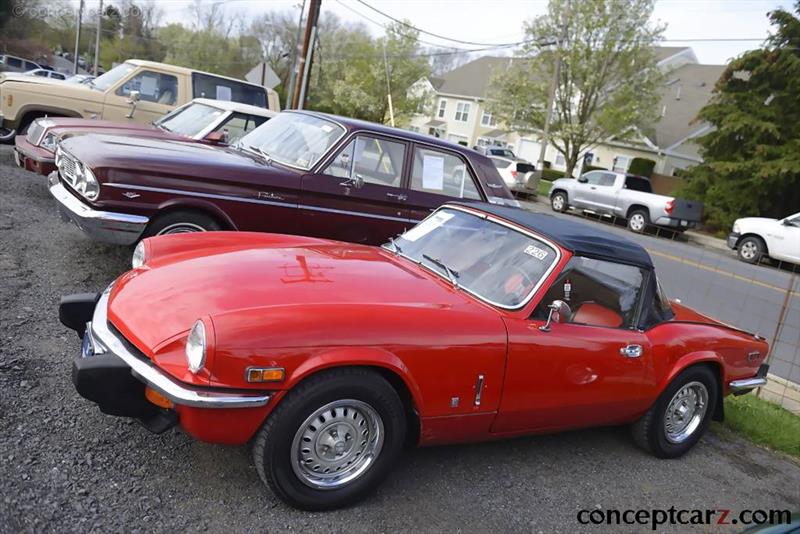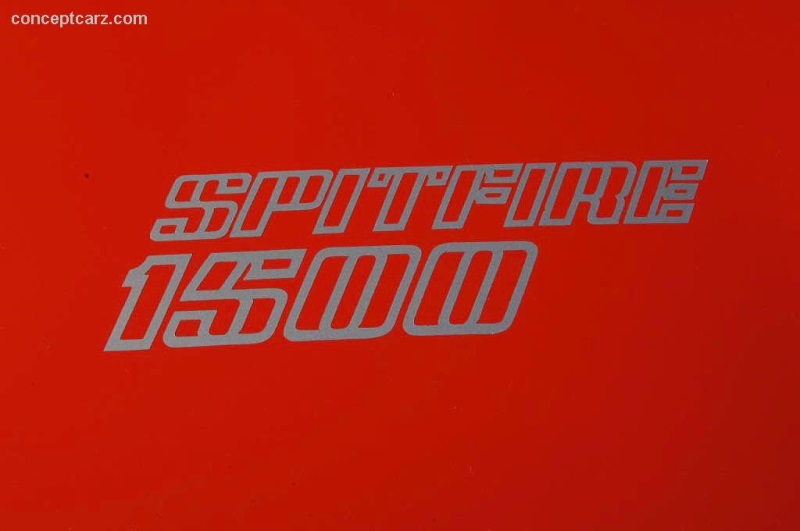The popularity of the small sports car greatly increased following World War II, with every aspect explored and exploited, from the budget-friendly roadster to the high-powered, luxurious cabriolet. Jaguar had success with its XK120, with demand quickly surpassing production. The success of the Austin-Healey Sprite, and its badge-engineered cousin - the MG Midget, convinced Triumph to offer an all-new, modern sports car. At the time, Triumph had a traditional roadster on its roster, the TR series (TR2, TR3, TR4, TR5, and TR6) equipped with a Standard wet liner inline four-cylinder engine with overhead valves. The all-new Spitfire wore a modern design courtesy of Italian designer Michelotti, with swooping bodywork and a unique single-piece front engine that tilted forwards to reveal unrivaled access to the engine. Introduced in 1962, it was a huge success and four subsequent variants ensued, the latest of which was the Mk. IV, complete with a 1500cc engine, a top speed of 100mph, and 0 to 60mph reached in 13.2 seconds. In the finest British tradition, the Spartan roadster employed niceties such as wind-up windows (the Spridgets still had side screens), a pair of SU carburetors to its little four-cylinder engine, and a four-speed gearbox (overdrive became an option from September 1963). Using many proven mechanical components from the Standard parts bin, the Spitfire was based on a heavily reworked Herald platform, utilizing the rack and pinion steering, independent double wishbone-type front suspension and swing axles at the rear from that model.The Triumph Spitfire, named in honor of the famous World War II fighters that helped win the Battle of Britain, was originally badged as the Spitfire 4 and was retrospectively dubbed the Mark I. Powered with a 1,147cc engine, it remained in production until the end of 1964, with 45,753 examples built in total. The production ultimately ceased in 1981 following many incarnations and evolutions, five generations, outselling the Midget in every year of production bar one. Along with success at the salesroom, the Spitfire achieved success on the track as well, placing first and second in class at Le Mans in 1965. In short, the Triumph Spitfire was easily maintained, inexpensive, and a rewarding British sports car. The Triumph Spitfire 4 (Mark I), built from October 1962 to December 1964, had one of the most powerful engines in the small sports car segment with very high torque ratings considering its size. Features not traditionally found on these budget-friendly roadsters were real wood on the dashboard, improved electrical systems, wiring and connectors, rubber mats, a large plastic steering wheel, relatively full instrumentation, exterior door locks, and upgraded knobs and switches. It used the body-on-frame construction of the Herald saloon/sedan, a rack and pinion steering, coil-and-wishbone front suspension (both from the Herald), and styling by Giovanni Michelotti, who had also designed the Herald. The rear suspension was by a single transverse-leaf swing axle arrangement which allowed the rear tires to endure large camber changes during hard cornering, often resulting in oversteer that could lead to losing control and spinning. Triumph later modified the rear suspension, and in 1970, it was de-cambered, incorporating what Triumph called a 'swing spring.' One of the leaf springs was removed with only the bottom leaf attached rigidly to the differential. The other leaves were mounted to pivot freely.The inline four-cylinder Standard SC engine had a pushrod overhead valve cylinder head, two valves per cylinder, twin SU carburetors, and a 1,147cc (70 cubic-inch) displacement. In U.K. specification, the engine delivered 63 horsepower at 5,570 RPM and 67 lb-ft of torque at 3,500 RPM. The introduction of the Spitfire was delayed due to the company's financial troubles during the early 1960s. Its arrival occurred after Standard Triumph was taken over by Leyland Motors, and when Leyland officials took stock of their new acquisition, they found the Michelotti prototype, which they quickly approved for production with only minor updates to its design, mostly to its bumpers. The full-width rear bumper of the prototype was replaced by two-part bumpers curving around each corner, with overriders. The wind-up windows and unique bonnet/hood designs remained.In 1964, an overdrive system became optional on the four-speed manual gearbox, and wire wheels and a hardtop were also available. 
Convertible Coupe
View info and historyFollowing several major updates, the Spitfire Mark II was introduced in March of 1965, with the engine gaining a revised camshaft profile, tubular exhaust manifold, water-heated intake manifold, and an increase in power to 67 bhp at 6,000 RPM. The examples destined for the North American market received ACDelco distributors and continued to use the coil-spring housing. The previous coil-spring design clutch was replaced by a Borg & Beck diaphragm spring clutch. The original moulded rubber floor mats were replaced by carpeting, the seats were given rubber cloth (on nearly all of its exposed surfaces), and the exterior got a new grille and badges. Production through 1967, a total of 37,409 examples were built. With the arrival of the Mark III in March of 1967, the Spitfire received its first major styling update since its introduction in 1962, partly in response to new crash regulations. (Safety and emissions regulations resulted in several modifications and updates during the Mark III production lifespan.) The frontal area decreased as the front bumper was raised, now positioned just below the round headlights, decreasing the side of the grille opening. The hood now used a conventional folding arrangement. In the back, the rear overriders were removed, and reversing lights were integrated into the bumper, initially as two separate lights on either side of the license (number) plate, and then as a single unit above the license plate. The interior received a smaller, 15-inch wire-spoked steering wheel, a wood-veneer instrument surround, and most of the instrument clusters were mounted in the center, as in the Mark I and Mark II. The center-mounted instrumentation allowed for both right-hand and left-hand drive configurations. Several significant updates were made to the mechanical components, including a new exhaust system that reduced the cabin nose, slightly raised coil springs, and a bored-out 1,296cc engine that retained the 3.0 inch (76mm) stroke of the 1,147cc unit but had a larger 2.90 inch (73.7 mm) bore (up from 2.73-inches). With SU twin-carburetors installed, the engine delivered 75 horsepower at 6,000 RPM and 75 lb-ft of torque at 4,000 RPM. In 1968, emissions were improved through the use of a distributor with idle speed ignition timing retarded, modifications to the SU carburetors (overrun valves in the throttle discs), and a revised camshaft. North American 'federalized' cars had a reduced compression ratio of 8.5:1 starting in 1969, which decreased power to 68 horsepower and 73 lb-ft of torque. The seats had integrated headrests, the wood dash was replaced with a matte black finish assembly, and the instrument panel was relocated to the front of the driver.
Convertible Coupe
View info and historyOptional equipment included a Laycock de Normanville overdrive system, a factory hard top, and wire wheels. Production of the Mark III continued into 1971, even after the introduction of the Mark IV, with a total of 65,320 units built. Although higher than the Mark I and Mark II's production, it would be less than the Mark IV and Spitfire 1500.An increase in engine displacement, styling updates, and a full-width dashboard brought about the introduction of the Triumph Spitfire Mark IV in 1970. Engine displacement grew to 1,296cc, and in 1973 it received larger big-end bearings. With 9:1 compression and twin SU HS2 carburetors, the U.K.-market examples produced 63 horsepower. The North American versions used 8.5:1 compression and a single Zenith Stromberg carburetor. The final drive ratio was changed from 4.11:1 to 3.89:1, and the gearbox gained synchromesh on its bottom gear. The rear suspension received a 'swing spring' (as described by Triumph), which greatly reduced the oversteer of the original swing-axle. Michelotti redesigned the rear of the Mark IV, giving it the family appearance of the Triumph 2000 and Triumph Stag models. The weld lines on top of the wings/fenders were revised with a new bonnet pressing, and the door handles were now recessed. The convertible top now had squared-off corners. The interior was given a full-width dashboard, like the later-built N.A.-market Mark III, and the instrumentation was placed in front of the driver, initially finished in black plastic and then from 1973 finished in wood.An updated hardtop design became available, with rear quarter lights and a flatter rear screen.Production of the Triumph Spitfire Mark IV lasted from 1970 to 1974, with 70,021 units built. The final revision of the Spitfire was known as the Spitfire 1500, referencing its 1,493cc Standard inline-4 engine. Its stroke had increased to 3.44 inches (87.5mm), resulting in a larger displacement size and an increase in torque. This engine was used by the United States and Canadian markets beginning in 1973 and the (ROW) rest of the world in 1975. Although larger in size, the engine was more prone to failure than the earlier units, and due to the addition of a catalytic converter and exhaust gas recirculating system, horsepower was lower. The rest of the world (ROW) units had a compression ratio of 8.0:1 while American market models had 7.5:1 compression and a single Zenith-Stromberg carburetor, allowing it to operate on lower octane unleaded fuel. The compression ratio was raised to 9.1:1 for the 1976 model year but reduced to 7.5:1 for the remaining years of production. Spitfires built for the U.K. market had 9:1 compression, used less restrictive emissions control equipment, and larger Type HS4 carburetors, resulting in the most powerful variant to date, with 71 hp (DIN) at 5,500 RPM and 82 lb-ft of torque at 3,000 RPM. Zero-to-sixty was accomplished in 13.2 seconds and tp speed at the magical 100 mph mark.The performance and stability improved thanks in part to the wider rear track, longer swing axles, and a lowered spring mounting point for a more negative camber.
Convertible CoupeDomestic market cars received reclining seats with 'chequered brushed nylon centre panels' and head restraints in early 1977 and a new set of column stalk-operated minor controls, replacing the previous dashboard-mounted switches and knobs. The American market Spitfire 1500, in compliance with safety regulations, wore large plastic over-riders and wing-mounted reflectors on the front and back wings/fenders. Chrome bumpers were used through 1978, while the 1979 and 1980 models wore black rubber bumpers with built-in over-riders supported by chassis extensions. Wire wheels were no longer optional, but the tonneau cover, hard top, overdrive, and map light remained popular. The final Triumph Spitfire produced was never used and currently resides in the Heritage Motor Museum at Gaydon.
Convertible CoupeThe Spitfire 1500 was produced from 1974 to 1980, with 95,829 units built. Over its 18-production lifespan, approximately 314,332 units were built.
by Daniel Vaughan | Jun 2022
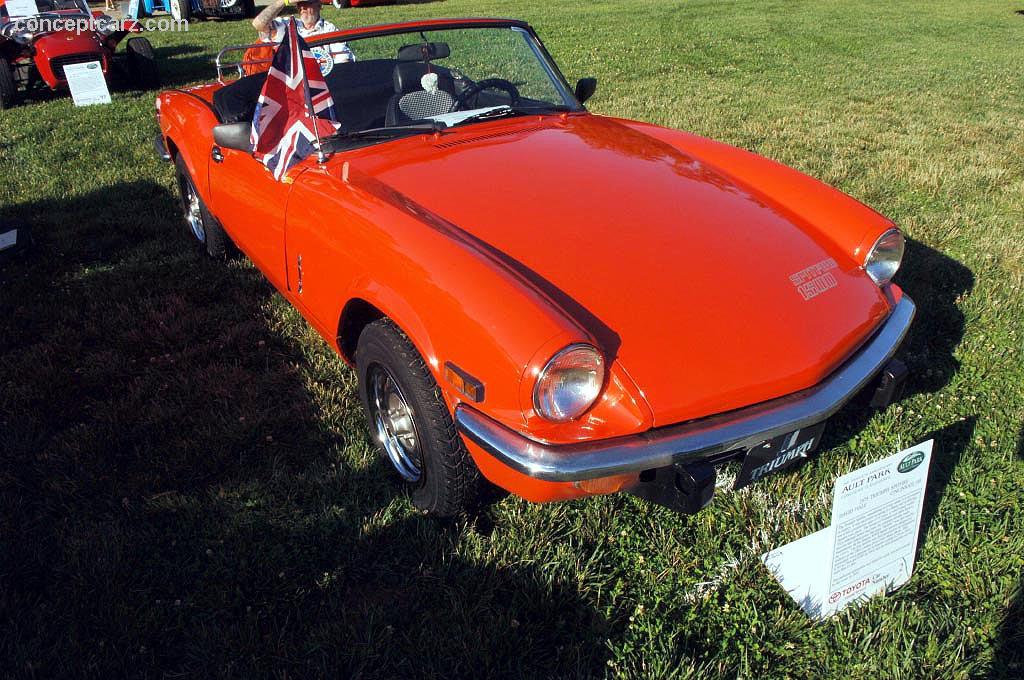
Convertible Coupe
View info and history
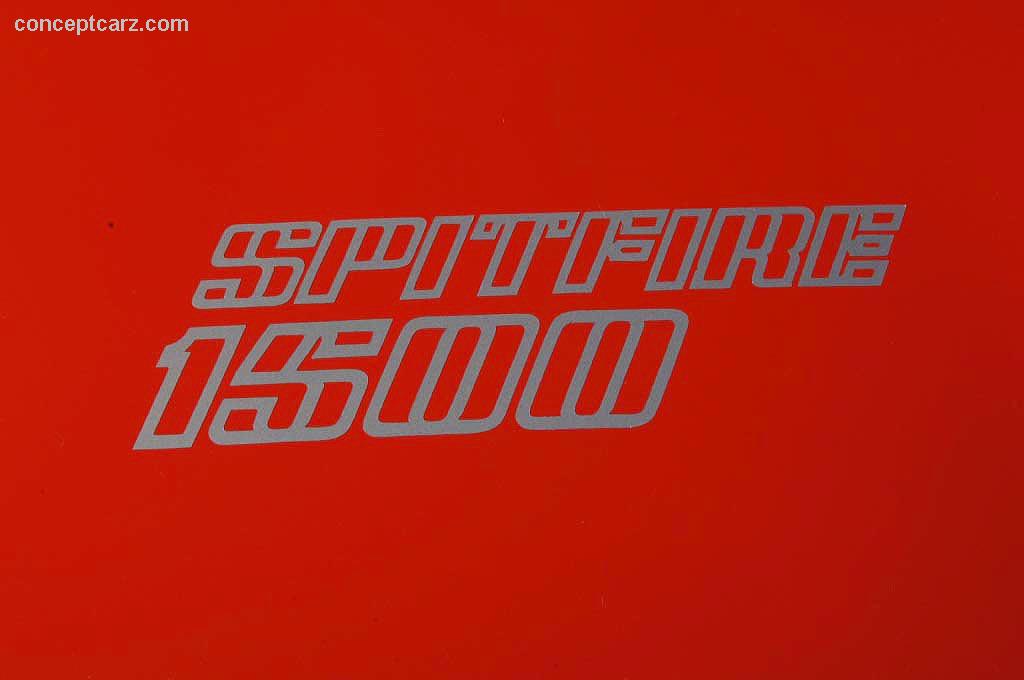
Convertible Coupe
View info and history
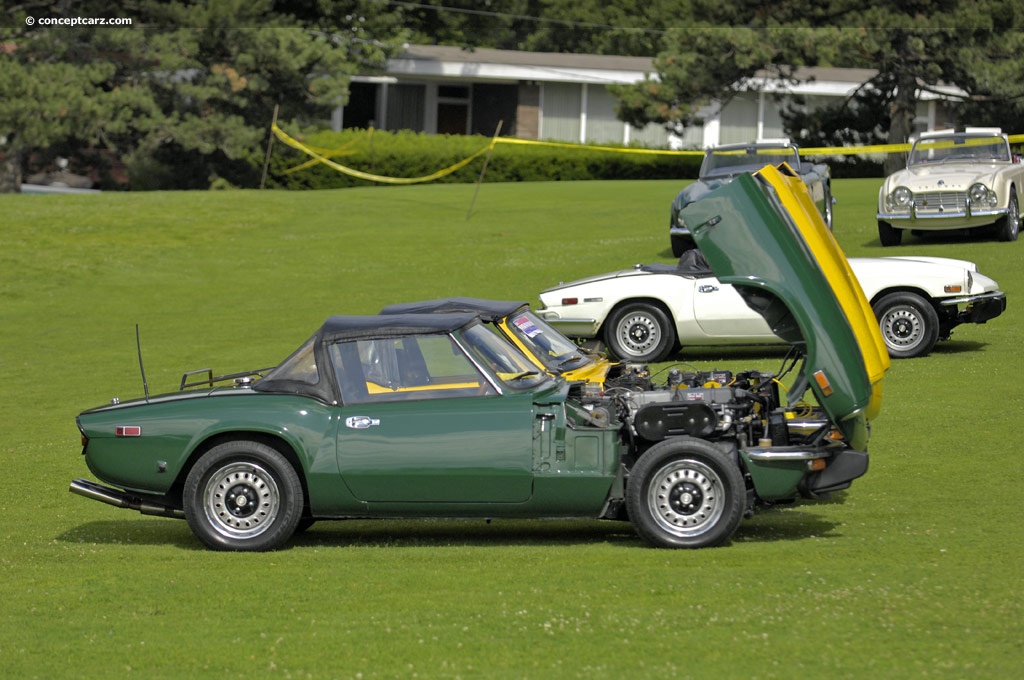
Convertible Coupe
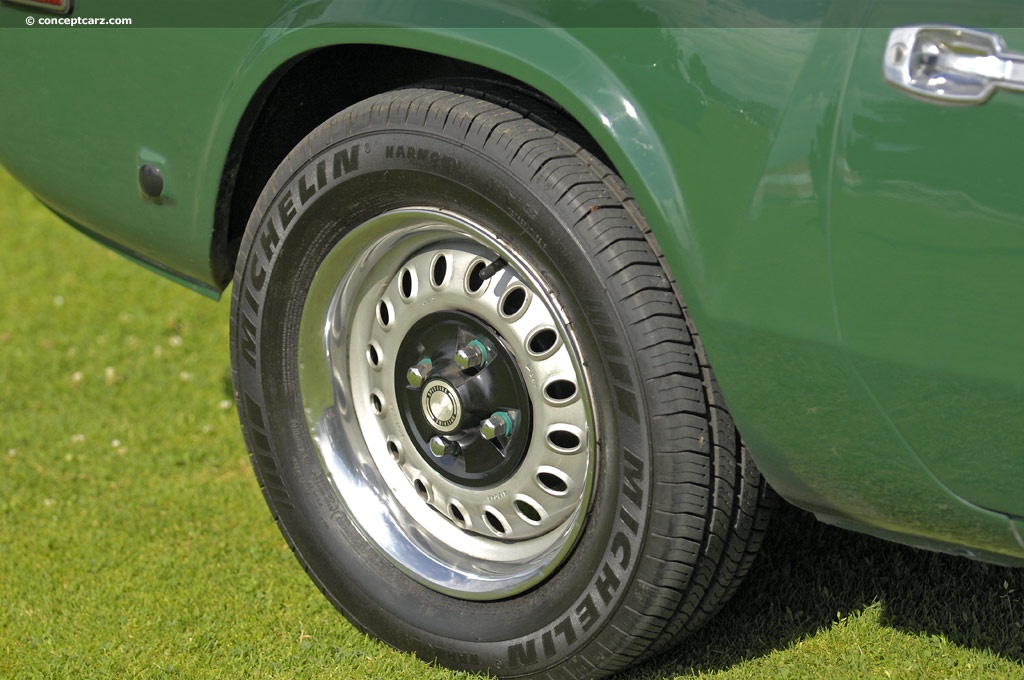
Convertible Coupe
by Daniel Vaughan | Jun 2022
Related Reading : Triumph Spitfire History
In 1962, the British company Triumph introduced a two-seater sports car named the Spitfire. The Austin-Healey Sprite had proven there was a demand for small cars with sporty intentions. Triumph wanted a piece of this market and felt they could produce a better automobile than the Sprite. In September of 1960, construction of a prototype began and was codenamed Bomb. Triumph used the mechanical....
Continue Reading >>
Continue Reading >>
Similar Automakers
Similarly Sized Vehicles
from 1975
1975 Triumph Spitfire 1500 Vehicle Profiles
Recent Vehicle Additions
Performance and Specification Comparison
Price Comparison
$5,150
$5,290
1500 Specification Comparison by Year
Year
Production
Wheelbase
Engine
Prices
Related Automotive News

18 Classic And Modern Cars On Offer Direct From The Private Collection Of Anthony Hamilton
A superbly presented Mercedes-Benz SLR McLaren Coupe with 11,000 miles
Seriously cool, Concours level 1957 Chevrolet Corvette C1
A totally restored Concours winning Autoglym Gold Champion Triumph TR3A
Possibly one of the best examples of a Trium...

Classic Mini Cooper S Waves The Flag At Barons' British Heritage, Classic & Sports Cars Sale - June 4, Sandown Park
After consolidating its strong start to 2019 by selling 63 of the lots on offer in its April sale, Barons is now looking forward to its a hrefhttpswww.barons-auctions.comview-auction3104-jun-2019---british-heritage-classic-and-sports-cars...

Alpine Passion Through The Years At Retromobile
Retromobile set to play host to six classic Alpine models
The Alpine Vision show car will also be on display as a symbolic bridge between the brands past and future
Groupe Renault is pleased to confirm Alpines participation in the 42nd Retromobi...

Refined Maseratis Add Italian Flair to The Pebble Beach Auctions Presented by Gooding & Company
Selections include - five Maseratis from a single renowned collection, a 1957 Maserati A6G54 Spyder, a 1971 Maserati Ghibli 4.9 SS Spider, a 1963 Maserati Sebring Series I and a 1960 Maserati 3500 GT
SANTA MONICA, Calif. (July 8, 2016) –...

ALPINE – THE EXCITEMENT BUILDS AT THE 2016 GOODWOOD FESTIVAL OF SPEED
Two show cars previewing the all-new Alpine sports car due to be unveiled at the end of this year
Strong Alpine presence at the exclusive Cartier Style %26 Luxe display
Three Alpines running up the hill, including the Alpine A460 competition car tha...




















